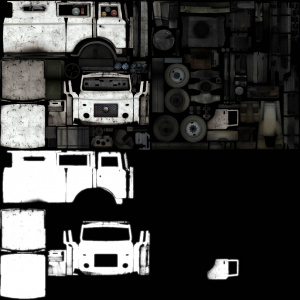$blendtintbybasealpha
$blendtintbybasealpha is a material shader parameter available in all ![]() Source games since
Source games since ![]() Left 4 Dead. It can be used in
Left 4 Dead. It can be used in ![]() Source 2013.
Source 2013.
It allows tinting of a model's material using the $basetexture's alpha channel as a mask to determine tint intensity (but not the tint's RGB color!) Applying an actual color RGB values is done elsewhere - either in-game or in Hammer with entities using the 'rendercolor' keyvalue. This technique is used in games like Left 4 Dead to allow for recoloring of the vehicle props, and in Team Fortress 2 for painting hats.
- $alphatest or $translucent - overrides both, disabling translucency. Use the Modulate shader as a workaround.
- $basealphaenvmapmask, at least in Source 2013, fails to load the shader combo. Use a separate $envmapmask.
- $selfillum, fails to load the shader combo. Using a separate selfillum mask has no effect. Use $detail with
$detailblendfactor 5as a workaround. [todo tested in?]
Contents
Usage
The tint mask simply controls the intensity of tinting. The more alpha, the more intense tinting is.
In practice, it is a good idea to use the mask to avoid tinting parts of the model that aren't covered by paint: either elements like lights, license plates, wheels, warning stripes, or scratched off, rusted or dirty areas, where the paint lost its effect.
Alternatively, this method can be used to only paint selected elements, like labels, colored glass, parts of clothing, character hair, makeup and so on.
Using
rendercoloron prop physics or prop dynamic entities without$blendtintbybasealpha. The tint is applied across the entire texture, which in this case is undesireable.
$blendtintcoloroverbase
$blendtintcoloroverbase, a related parameter, controls the amount of color replacement versus tinting. (replacing the color per pixel entirely, versus adding more color to make the colors closer to the tint RGB color.) A value of '0' will be full tint while a value of '1.00' will replace the albedo in the mask area with the color defined with $color2.




